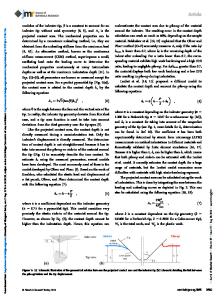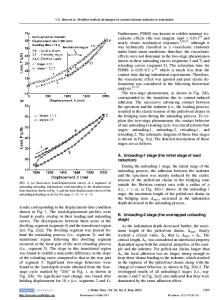Contact area determination in indentation testing of elastomers
- PDF / 2,257,779 Bytes
- 13 Pages / 584.957 x 782.986 pts Page_size
- 56 Downloads / 448 Views
H. Matthias Deuschle Institute of Statics and Dynamics of Aerospace Structures, University of Stuttgart, Stuttgart, Baden Wuerttemberg 70569, Germany
Susan Endersb) and Eduard Arztc) Max-Planck-Institute for Metals Research, Stuttgart, Baden Wuerttemberg 70569, Germany (Received 3 June 2008; accepted 23 September 2008)
To evaluate mechanical properties by means of nanoindentation, information on the contact area is crucial. However, the contact area is not directly accessible in experiments and is usually calculated according to the Oliver and Pharr procedure, which turned out to be unsatisfying when applied to viscoelastic materials like polymers. In this study, complementary in situ indentation testing and finite element analysis (FEA) were performed on silicone elastomers. Through this combination of techniques, several individual error sources in the conventional contact area determination have been identified and quantified. For shallow penetrations, contact areas after Oliver and Pharr were up to 40% smaller than the in situ testing results; for larger penetrations, the contact size was overestimated by approximately 6%. The deviations of the resulting mechanical properties were approximately 10%. Viscoelastic effects could be captured if dynamic indentation testing was performed. I. INTRODUCTION
Depth-sensing indentation techniques have nowadays become very popular for mechanically characterizing different kinds of materials across size scales. To establish nanoindentation as a reliable means of mechanical testing, many efforts were made to get a better knowledge of the mechanics and deformation mechanisms involved in the indentation process, because this is inevitable for a successful analysis of indentation data. In this respect, simulations of the indentation process, e.g., with finite element (FE) methods1–15 or atomistic simulations,16–20 have proven to be a useful tool to help in understanding the mechanics of indentation. Simulations allow the researchers to investigate issues easily, which cannot be directly accessed experimentally or require complicated and time-consuming experimental work. Furthermore, it is possible to vary certain parameters in a systematic way and analyze their influences on the indentation process, which provided deeper insight in different aspects of indentation testing,21 e.g., for evaluating constitutive material models,1,2 understanding a)
Address all correspondence to this author. e-mail: [email protected] b) Present address: Engineering Mechanics, University of Nebraska, Lincoln, NE c) Present address: INM-Leibniz Institute for New Materials, Saarbru¨cken, Germany DOI: 10.1557/JMR.2009.0093 736
http://journals.cambridge.org
J. Mater. Res., Vol. 24, No. 3, Mar 2009 Downloaded: 18 Mar 2015
effects of the tip geometry,3,4 or improving thin-film testing.5–8 One of the most important purposes of simulating the indentation process is the accurate determination of the contact area between the specimen and the indenter.7–12 During a standard indentation test, it is not po
Data Loading...











